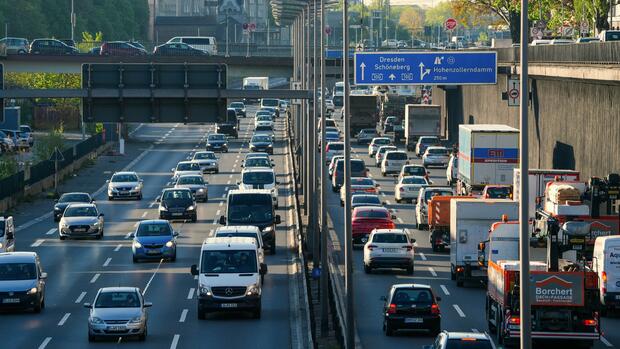The federal government wants to draw up a federal transport route and mobility plan in the future.
(Photo: dpa)
Berlin When the Federal Ministry of Transport invites you to an “Infrastructure Dialogue”, the invited group does not have to content itself with a boring discussion in a sparse conference room. This Friday, a moderator will lead through the six-hour program.
She will also ensure that the representatives of the 15 invited associations do not exceed their speaking time of three minutes each and answer the given question: Should the federal government invest in the transport networks to be able to cope with the growing traffic? Or is the focus on ensuring that the transport infrastructure makes the greatest possible contribution to achieving climate protection goals?
The question alone causes a lot of confusion among the guests. “We need an efficient infrastructure so that we can achieve the climate targets,” emphasizes Uta Pfeiffer, Head of the Mobility and Logistics Department at the Federation of German Industries. “An either/or policy is the wrong way to go.”
The ADAC points out that new roads will not solve the climate problems. It is more important and “vital for the business location” to renovate dilapidated bridges.
“We are making progress in terms of CO2 reduction primarily through the electrification of the vehicle fleet,” says Stefan Gerwens, Head of the Transport Department. This requires a much faster expansion of the charging infrastructure, for example along the trunk roads.
The federal government’s mobility plan should also take energy and data networks into account
The federal government has set itself the goal of creating a federal traffic route and mobility plan in future instead of a federal traffic route plan. But what exactly that should be, opinions differ.
The ministry sent out “core messages” in advance: According to this, the ministry refers to the unchecked growth in traffic and that shifting traffic from road to rail does not automatically help the climate. Transport modes should not be played off against each other.
It goes on to say that a “stop to new construction of roads” “endangers the needs-based transport infrastructure”. The aim must be for cars, trucks, trains and ships to be powered by climate-neutral drives in the future.
For the associations, this view does not go far enough. “A mobility plan must also take the energy networks, charging and data networks into account and create the planning and investment security that has been missing for the state’s economy,” says Markus Emmert from the Federal Association for eMobility.
>> Read here: To protect the climate, Wissing relies on new truck drives instead of trains
The turnaround in mobility will only succeed if the forecast traffic growth by 2051 of more than 50 percent in freight traffic and an increase of 13 percent in passenger traffic is accompanied by energy management. To do this, the federal government must promote an electrically operated vehicle mix that also includes light vehicles, from bicycles to motorcycles and cargo bikes in local goods transport, says Emmert.
The transport sector must become more climate-friendly.
(Photo: dpa)
Above all, the associations do not want to simply accept the traffic forecast presented by Transport Minister Volker Wissing (FDP) in March. In a letter to the ministry, the network of European railways demands that “a jolt goes through the house”. The Ministry is trying to present transport policy as “uncontrollable”.
Wasilis von Rauch, Managing Director of Zukunft Fahrrad, criticizes that the expansion of the infrastructure for cars and trucks leads to more car and truck traffic. This in turn will be continued in the models for the future and supposedly require additional infrastructure. This cycle contradicts “what is necessary in terms of transport and climate policy”.
Environmental groups want climate protection as a basis for transport infrastructure
Roland Stimpel, CEO of Fuss eV, also argues that traffic that requires as little energy and space as possible is efficient. “This applies to the means of transport used as well as to the distances traveled – one can also promote shorter instead of longer distances in terms of transport policy.”
Like the Greens in the traffic light coalition, the invited environmental organizations are calling for every planned transport project from the Federal Transport Routes Plan to be reviewed again and not built for as long. “Climate and nature conservation goals must finally become the basis for evaluating all infrastructure planning,” say Greenpeace, the Nature Conservation Union, the German Traffic Club and others in a paper.
But the political reality points in a different direction. In the middle of the week, the Federal Cabinet decided to declare a number of motorway and rail projects to be of “outstanding public interest” and thus to implement them in a hurry. Economics Minister Robert Habeck (Greens) was able to negotiate the six-lane expansion of the A23 from Pinneberg to Hamburg out of the project list on Tuesday – out of consideration for his home country Schleswig-Holstein.
On Friday, the associations can discuss at so-called “theme tables” which criteria could be used in the future to create a “Federal Transport Routes and Mobility Plan 2040”. The Ministry itself has commissioned reports. A result should be available in 2024.
More: Transport industry in turmoil: Wissing should not introduce climate tolls until 2025 at the earliest

